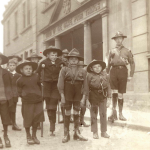State of Museum Access 2018
Survey results this year shows that a majority of accredited museums now provide some information for disabled visitors, but it is often thin and only covers those with a mobility impairment.
 Chiswick House, London
Chiswick House, London
 Maison Dieu, Faversham
Maison Dieu, Faversham
 Liverpool School for the Indigent Blind, Liverpool
Liverpool School for the Indigent Blind, Liverpool
 Langdon Down Museum of Learning Disability, Teddington
Langdon Down Museum of Learning Disability, Teddington
 The Royal School for Deaf Children, Margate
The Royal School for Deaf Children, Margate
 Guild of the Brave Poor Things, Bristol
Guild of the Brave Poor Things, Bristol
 St Saviour’s Deaf Church, Acton
St Saviour’s Deaf Church, Acton
 Grove Road Housing Scheme, Sutton-in-Ashfield
Grove Road Housing Scheme, Sutton-in-Ashfield
Web editor at the History of Place project
Survey results this year shows that a majority of accredited museums now provide some information for disabled visitors, but it is often thin and only covers those with a mobility impairment.
Listen to audio and watch the film which preserves material from The School for the Blind: Pioneering People and Places exhibition
Follow our digital story set in 1236, at Maison Dieu, a monastic hospital on the pilgrim road to Canterbury.
Jessica is founder of ‘Dyspraxic Me’ a charity for young adults with dyspraxia. She is seeking neurodiverse people to contribute to research for her MA. Can you help?
Our display in partnership with the Victoria and Albert Museum, London, which runs to 20th October, looks at how disabled people are increasingly leading innovative accessible building design.
David Bonnett is an architect whose work features in our exhibition in partnership with the V&A Without Walls: Disability and Innovation in Building Design. He is also disabled himself and so brings personal experience to the creation of inclusive design.
Pam Friend knows that her great-grandparents were both deaf and that one or both may have attended the Royal School for Deaf Children in Margate. Now she is trying to find out more about their lives.
Jess Starns, who has been advising the project, discusses her experiences at our three exhibitions and two symposiums.
Museums still have a long way to go in representing and making provision for disabled people – but there are some good news stories and there are simple, as well as ‘ambitious’ changes that all museums can make.
‘Has the applicant ever begged?’ In the early days admittance to the School came with strict rules (and some intrusive questions).